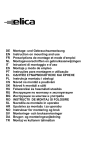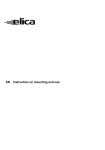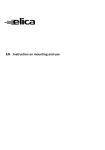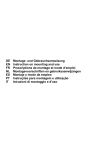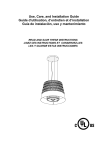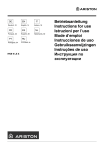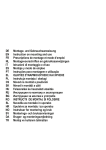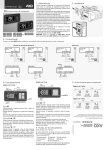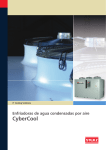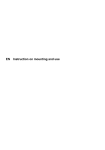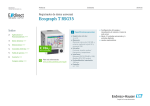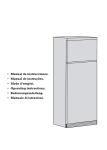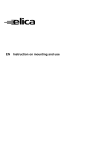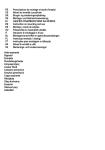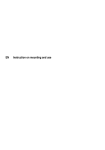Download Elica Light Pyramid Island
Transcript
DE EN FR NL IT ES PT EL PL CS SK HU RU BG RO SL HR NO SV DA TR Montage- und Gebrauchsanweisung Instruction on mounting and use Prescriptions de montage et mode d’emploi Montagevoorschriften en gebruiksaanwijzingen Istruzioni di montaggio e d'uso Montaje y modo de empleo Instruções para montagem e utilização ΟΔΗΓΙΕΣ ΣΥΝΑΡΜΟΛΟΓΗΣΗΣ ΚΑΙ ΧΡΗΣΗΣ Instrukcja montażu i obsługi Návod na montáž a používání Návod k montáži a užití Felszerelési és használati utasítás Инструкции по монтажу и эксплуатации Инструкции за монтаж и употреба INSTRUCTII DE MONTAJ SI FOLOSIRE Navodila za montažo in uporabo Uputstva za montažu i za uporabu Instrukser for montering og bruk Monterings- och bruksanvisningar Bruger- og monteringsvejledning Montaj ve kullanım talimatları EN - Instruction on mounting and use Closely follow the instructions set out in this manual. All responsibility, for any eventual inconveniences, damages or fires caused by not complying with the instructions in this manual, is declined. The extractor hood has been designed exclusively for domestic use. The hood can look different to that illustrated in the drawings in this booklet. The instructions for use, maintenance and installation, however, remain the same. ! It is important to conserve this booklet for consultation at any moment. In the case of sale, cession or move, make sure it is together with the product. ! Read the instructions carefully: there is important information about installation, use and safety. ! Do not carry out electrical or mechanical variations on the product or on the discharge conduits. Note: the elements marked with the symbol “(*)” are optional accessories supplied only with some models or elements to purchase, not supplied. Caution WARNING! Do not connect the appliance to the mains until the installation is fully complete. Before any cleaning or maintenance operation, disconnect hood from the mains by removing the plug or disconnecting the mains electrical supply. Always wear work gloves for all installation and maintenance operations. The appliance is not intended for use by children or persons with impaired physical, sensorial or mental faculties, or if lacking in experience or knowledge, unless they are under supervision or have been trained in the use of the appliance by a person responsible for their safety. This appliance is designed to be operated by adults, children should be monitored to ensure that they do not play with the appliance. This appliance is designed to be operated by adults. Children should not be allowed to tamper with the controls or play with the appliance. Never use the hood without effectively mounted grating! The hood must NEVER be used as a support surface unless specifically indicated. The premises where the appliance is installed must be sufficiently ventilated, when the kitchen hood is used together with other gas combustion devices or other fuels. The ducting system for this appliance must not be connected to any existing ventilation system which is being used for any other purpose such as discharging exhaust fumes from appliances burning gas or other fuels. The flaming of foods beneath the hood itself is severely prohibited. The use of exposed flames is detrimental to the filters and may cause a fire risk, and must therefore be avoided in all circumstances. Any frying must be done with care in order to make sure that the oil does not overheat and ignite. Accessible parts of the hood may became hot when used with cooking applicance. With regards to the technical and safety measures to be adopted for fume discharging it is important to closely follow the regulations provided by the local authorities. The hood must be regularly cleaned on both the inside and outside (AT LEAST ONCE A MONTH). This must be completed in accordance with the maintenance instructions provided in this manual). Failure to follow the instructions provided in this user guide regarding the cleaning of the hood and filters will lead to the risk of fires. Do not use or leave the hood without the lamp correctly mounted due to the possible risk of electric shocks. We will not accept any responsibility for any faults, damage or fires caused to the appliance as a result of the nonobservance of the instructions included in this manual. This appliance is marked according to the European directive 2002/96/EC on Waste Electrical and Electronic Equipment (WEEE). By ensuring this product is disposed of correctly, you will help prevent potential negative consequences for the environment and human health, which could otherwise be caused by inappropriate waste handling of this product. on the product, or on the documents The symbol accompanying the product, indicates that this appliance may not be treated as household waste. Instead it should be taken to the appropriate collection point for the recycling of electrical and electronic equipment. Disposal must be carried out in accordance with local environmental regulations for waste disposal. Use The hood has been made for use in the internal recirculating filtering version. Cooking fumes and steam are aspirated inside the hood, filtered and cleaned, passing through the fat filter/s and the carbon filter/s that MUST be supplied with the hood. Important It is possible to buy an extraction operation Kit. In this case the charcoal filter must not be installed. Furthermore, the use of the extraction kit may require a different installation of the hood from what shown in this manual; therefore, before starting the installation of the hood, buy the extraction kit and consult the instructions enclosed with the kit. Installation Specialised personnel must carry out both the electrical and the mechanical installation. The minimum distance between the supporting surface for the cooking equipment on the hob and the lowest part of the range hood must be not less than 50cm from electric cookers and 65cm from gas or mixed cookers. If the instructions for installation for the gas hob specify a greater distance, this must be adhered to. Electrical connection The mains tension must correspond to the tension shown on the characteristic label situated inside the hood. The product is meant for connecting directly to the mains supply, therefore apply a regulation bipolar switch that ensures complete disconnection from the mains in the conditions of category III over-tension, conforming to the installation rules. Warning! Detail B (fixing bracket to the ceiling - Fig. 1) is equipped with a conductor (yellow-green) that must be connected to the earth of the domestic electrical plant. Fig. 4 Warining! Changing the interconnection cable must be carried out by the authorised technical assistance service. Mounting This type of cooker hood must be fixed to the ceiling. Expansion wall plugs are provided to secure the hood to most types of walls/ceilings. However, a qualified technician must verify suitability of the materials in accordance with the type of wall/ceiling. The wall/ceiling must be strong enough to take the weight of the hood. Do not tile, grout or silicone this appliance to the wall. Surface mounting only. Certain models are supplied WITHOUT panels (Panelable Version) in order to allow personalization of the product. Attention!: The materials used to panel the Panelable Version must meet the requirements of the General European Household Appliance Standard EN 60335-1 and in particular the cooker hood standard EN 60335-2-31. Elica S.p.A. Refuses all responsibility for any damage deriving from the use of materials not complying with such requirements. Attention!: Do not connect the appliance to the power supply system until the installation of the hood and the panels has been completed. On the first pages of this manual you will find the technical drawings necessary to determine the right dimensions of the panels and the fixing points. Fig. 18-19 Description of the hood Fig. 1 A. Cover B. Support to the ceiling bracket C. Tie-rods of the hood D. Decorative cover E. Box for connecting to the domestic power network F. Interconnection cable G. Halogen bulb H. Active carbon filter I. Metal anti-fat filter J. Panel. K. Side lamp L. Control lever Attention! The control lever is already supplied. It is to be installed last, before connecting the hood to the mains. Insert the control lever into the apposite housing (see drawings on the first pages of this booklet - triggered connection, compulsory direction. Operation Use the high suction speed in cases of concentrated kitchen vapours. It is recommended that the cooker hood suction is switched on for 5 minutes prior to cooking and to leave in operation during cooking and for another 15 minutes approximately after terminating cooking. The hood is equipped with a “TOUCH” device to control the lights and speed. For the correct use please carefully read the intructions below. The cooker hood can be controlled through a remote control available as accessory kit (see the paragraph relating to the functioning of the remote control). Grease filters need cleaning: FLASHING GREEN LED light (read instructions found under “Reset and configuration for filter saturation signal”) Coal filters must be cleaned or replaced: FLASHING ORANGE (amber) LED light (read instructions found under “Reset and configuration for filter saturation signal”) Note: The reset procedure may be activated by both the control panel and the remote control. Center light check The center light may be switched on and off by pressing the T2 button on the control panel. Side light check (when scheduled) The side lights may be switched on and off by pressing AND HOLDING DOWN the T2 button on the control panel. HOLDING DOWN the button, besides permitting to switch the hood on and off, it also regulates the light intensity given from the lights. Note: The switching on and off functions (and regulating function) alternate. The regulation of the light intensity is not available for hoods with neon lights. Automatic start-up function The hood is equipped with a temperature sensor which activates the motor to the first suction speed (power) in the event that the room temperature in the surrounding area is higher than 70°C. The user may switch off or modify the suction speed (power) (see paragraph “suction speed (power) control”). Suction speed (power) control The suction speed (power) is cyclical depending on the speed sequence “stand-by – 1-2-3-4- Stand by -1-2-...” therefore every time the T1 button is pressed on the control panel, the suction speed (power) is increased by one level, in order to switch off (stand-by) if the button is pressed again when the hood is in suction speed (power) 4. The hood may be switched off (stand-by) while the hood is set on any speed by holding down the T1 button on the control panel for a bit longer (more than 3 seconds). The hood's suction speed (power) may be determined as the control panel is equipped with a LED light that changes colors as follows, depending on the suction speed (power): Hood in stand-by: LED LIGHT SWITCHED OFF 1st suction speed (power) -GREEN LED LIGHT 2nd suction speed (power) – ORANGE LED LIGHT (amber) 3rd suction speed (power) - RED LED LIGHT 4th suction speed (power) - RED LED LIGHT (FLASHING) Note: The 4th suction speed (power) stays on for 5 minutes, after which the suction motor will position itself on the 2nd speed. If pressed again, the suction motor will switch off (stand-by). Reset and configuration for filter saturation signal Switch on hood to any speed (see above paragraph “Suction speed (power) selection”) Reset grease filter saturation signal (FLASHING GREEN LIGHT on control panel) First proceed with filter maintenance as described in corresponding paragraph. Press and hold down (for more than 3 seconds) the T1 button on the control panel, the LED light will stop flashing indicating that the signal reset has been carried out, the hood will switch off. Reset coal filter saturation signal (FLASHING ORANGE (amber) LED light) First proceed with filter maintenance as described in corresponding paragraph. Press and hold down (for more than 3 seconds) the T1 button on the control panel, the LED light will stop flashing indicating that the signal reset has been carried out, the hood will switch off. Coal filter saturation signal disactivaction (for particular applications) Switch off hood (see above paragraph “suction speed (power) selection”). Press and hold down (for more than 5 seconds) the T1 button on the control panel, the LED light will start flashing GREEN indicating that the coal filter saturation signal has been disactivated. In order to reactivate the coal filter saturation signal, repeat operation, the LED light will flash ORANGE (amber) Using the remote control The remote control is able to control all the functions of the hood: Select the suction speed (power) Control the central light Control the lateral lights Reset e configure the saturation of the filters signal Selecting the suction speed (power): Press the "◄" key or the "►" key until you see the symbol relating to the “Select the suction speed (power)” function. Press the “+” key or the “-” key or the "■" key respectively to increase or diminish or switch off (stand-by) the speed (suction power). Controlling the central light: Press the "◄" key or the "►" key until seeing the symbol relating to the “Controlling the central light” function on the remote control. The central light can be switched on and off in two ways: 1. Press the “+” key or the “-” key respectively to switch the central light (ON) or (OFF). 2. Press the "■" key to change the state of the light from (OFF) to (ON) or vice versa. Controlling the lateral lights: Press the "◄" key or the "►" key until seeing the symbol relating to the “Controlling the lateral lights” function on the remote control. Press the "■" key to change the state of the lateral lights from (OFF) to (ON) at maximum intensity and viceversa. Press the “-” key to diminish the intensity of the lateral lights until switching them off. Press the “+” key to increase the intensity of the lateral lights. Resetting and configuring the saturation of the filters signal Switch the hood on at any speed (see paragraph above “Selecting the suction speed (power”). Press the "◄" key or the "►" key until seeing the symbol relating to the “Resetting and configuration of the saturation of the filters signal” function on the remote control. Resetting the anti-fat filter saturation signal (GREEN LED FLASHING on the control bar) First proceed with the maintenance of the filter as described in the corresponding paragraph. Press the “+” and “-” keys contemporaneously for about 3 seconds. The LED stops flashing, indicating that the resetting of the signal has been accomplished. Resetting the carbon filter saturation signal (ORANGE (amber) LED FLASHING) Note! The reset of the carbon filter saturation signal is normally deactivated. To activate it, see under paragraph “Activating the carbon filter saturation signal”. First proceed with the maintenance of the filter as described in the corresponding paragraph. Press the “+” and “-” keys contemporaneously for about 3 seconds. The LED stops flashing, indicating that the resetting of the signal has been accomplished. Deactivating the carbon filter saturation signal (for special applications) Switch the hood off (see paragraph above “Selecting the suction speed (power)”). Press the "◄" key or the "►" key until seeing the symbol relating to the “Resetting and configuration of the filters saturation signal” function on the remote control. Press keys “+” and “-” contemporaneously for about 3 seconds. The LED flashes in GREEN to indicate that the carbon filter saturation signal has been deactivated. To reactivate the carbon filter saturation signal, repeat the operation. The LED flashes in ORANGE. Maintenance of the remote control Cleaning the remote control: Clean the remote control with a damp cloth and a neutral solution of detergent without abrasive substances. Changing the battery: • Open the battery casing using a small screwdriver with a flat point. • Change the finished battery with a new one of 12 V type MN21/23 In inserting the new battery respect the polarity indicated on the battery casing! • Close the battery casing up again. Disposal of the batteries Ultimate disposal of the batteries should be handled according to all national laws and regulations. Do not place used batteries in your regular waste. Ultimate disposal of the batteries must be done safely. Contact your local waste management officials for other information regarding the environmentally sound collection, recycling, and disposal of the batteries. Maintenance ATTENTION! Before performing any maintenance operation, isolate the hood from the electrical supply by switching off at the connector and removing the connector fuse. Or if the appliance has been connected through a plug and socket, then the plug must be removed from the socket. Cleaning The cooker hood should be cleaned regularly (at least with the same frequency with which you carry out maintenance of the fat filters) internally and externally. Clean using the cloth dampened with neutral liquid detergent. Do not use abrasive products. DO NOT USE ALCOHOL! WARNING: Failure to carry out the basic cleaning recommendations of the cooker hood and replacement of the filters may cause fire risks. Therefore, we recommend oserving these instructions. The manufacturer declines all responsibility for any damage to the motor or any fire damage linked to inappropriate maintenance or failure to observe the above safety recommendations. Panel Fig. 13 - 16 Clean the perimeter aspiration panel with the same frequency as the ant-fats filter, using a cloth and not too concentrated liquid detergent. Do not use abrasive substances. Grease filter Fig. 14-16 Traps cooking grease particles. This must be cleaned once a month (or when the filter saturation indication system – if envisaged on the model in possession – indicates this necessity) using non aggressive detergents, either by hand or in the dishwasher, which must be set to a low temperature and a short cycle. When washed in a dishwasher, the grease filter may discolour slightly, but this does not affect its filtering capacity. To remove the grease filter, pull the spring release handle. Charcoal filter (filter version only) Fig. 15 It absorbs unpleasant odours caused by cooking. The saturation of the activated charcoal occurs after more or less prolonged use, depending on the type of cooking and the regularity of cleaning of the grease filter. In any case it is necessary to replace the cartridge at least every four mounths (or when the filter saturation indication system – if envisaged on the model in possession – indicates this necessity). Remove the grease filters. Fit the charcoalfilters over the motor. Align the pins R on the cowl with the slots S, then turn the filter clockwise until it locks in place. Reverse the above procedure to remove the charcoal filters. Refit the grease filters. Replacing lamps Fig. 1-12-16 Disconnect the hood from the electricity. Warning! Prior to touching the light bulbs ensure they are cooled down. Replacing central lamps 1. Using a flat head screwdriver or equivalent tool, carefully pry loose the light cover. 2. Remove the damaged light and replace with a new 12 Volt, 20 Watt (Maximum) halogen light made for a G-4 base SUITABLE FOR USE IN OPEN LUMINAIRES. Follow package directions and do not touch new light with bare hands. 3. Reinstall the light cover. (it will snap shut). Replacing lateral lamps. Replace with a new 12 Volt, 20 Watt (Maximum) halogen light made for a G-4 base SUITABLE FOR USE IN OPEN LUMINAIRES. Follow package directions and do not touch new light with bare hands. If the lights do not work, make sure that the lamps are fitted properly into their housings before you call for technical assistance.














